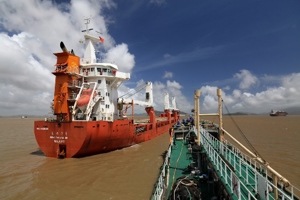China's Unipec fights uphill battle to contain Middle East crude prices
(Reuters) - The production cuts by OPEC+ may aim to keep crude prices high enough to satisfy the exporter group, but they are also starting to drive some unusual dynamics in the broader oil market.
An example is the trade in physical cargoes from the Middle East where Unipec, the trading arm of top Chinese refiner Sinopec, has been selling heavily this month.
A total of 64 cargoes, the bulk of which are Omani crude, have been traded so far in June, according to data compiled by Refinitiv Oil Research.
This is a large number by historical standards and Unipec has been the seller in about two-thirds of the cargoes traded.
It appears that Unipec is trying through its aggressive selling to influence the regional Oman/Dubai regional price benchmark, most likely to keep it anchored around $75 a barrel.
The Oman/Dubai benchmark is used by Saudi Aramco as a basis for setting its monthly official selling prices (OSPs) for Asian refiners, which buy about two-thirds of the cargoes from the world's largest crude exporter.
In effect what Unipec appears to be trying to do is limit the price increase in Middle East crudes, which have become more expensive relative to grades from the Atlantic Basin in the wake of the additional cuts to output announced by OPEC+ in early April.
The Saudi decision to voluntarily cut another 1 million barrels per day (bpd) of production for July also helped drive the price of Middle East grades higher relative to crude from producers in Africa and the Americas.
Unipec would no doubt like to see the Saudis lower their OSPs for August-loading cargoes, after the unexpected increase in OSPs for shipments in July.
Aramco raised the OSP for its benchmark Arab Light grade for refiners in Asia by 45 cents a barrel to a premium of $3.00 over Oman/Dubai quotes, the highest in six months.
The hike surprised refiners, who had tipped in a survey ahead of the June 5 announcement that Aramco would cut the OSP for Arab Light by more than $1 a barrel.
The impact of the increase in the Saudi OSPs, which tend to be followed by other Middle Eastern producers, was to make crude from the region more expensive relative to other grades.
While this has driven Asia's refiners to buy more crude from Africa and the Americas, there simply isn't enough available and they have no choice but to continue to buy from the Middle East.
The question is whether Unipec can be successful in keeping the Oman/Dubai price contained, and thus the OSPs, or whether strong demand in Asia for crude will win out in the end.
Brent Premium evaporates
While global benchmark Brent crude futures and U.S. West Texas Intermediate have been weakening in recent weeks, the price for Middle East crudes have held up.
The Brent-Dubai exchange for swaps , which measures the difference between Brent and Dubai crudes, flipped into a discount of 7 cents barrel on Wednesday, the first time since November 2020 that Brent has traded at a discount to Dubai.
The exchange for swaps has been trending lower since Nov. 3, when Brent was $9.09 a barrel higher than Dubai.
There are several reasons for this, including the output cuts implemented by OPEC+, which effect more Middle East grades than Brent and related light crudes.
There is also the increased demand for crude in Asia, especially from China and India, the world's top and third-biggest importers.
Asia is expected to import 29.12 million bpd in June, a third consecutive monthly gain and up from 26.47 million bpd in May, according to Refinitiv.
China's imports are estimated at 12.5 million bpd, up slightly from May's 12.16 million, while India is forecast to receive 5.24 million bpd, up from 4.74 million bpd in May.
Asia's imports from the United States are expected to reach a record high of 2.58 million bpd in June, up from 1.66 million bpd the prior month.
But it's worth noting that 920,000 bpd increase in imports from the United States is just over one-third of the total increase of 2.65 million bpd in Asia's imports in June from May.
What this shows is that as long as Asia's crude demand remains strong, the Middle East producers are likely to be able to command a premium for their crude, and strategies such as what Unipec has being doing are likely to provide only temporary relief.
The risk for the Middle East exporters is that demand in Europe and North America weakens faster than it can grow in Asia, which may happen if the developed economies enter recession as higher interest rates slam growth.







Comments